by Leslie Layton
posted Feb. 4
Part II in a two-part series
Thirty-five years ago, a small, progressive coalition stopped development in the lower foothills adjacent to Upper Bidwell Park with the rallying cry, “No way San Jose.”
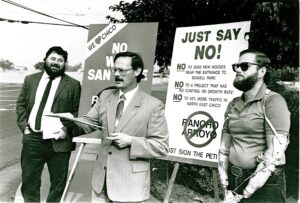
That area has been protected under the name of Bidwell Ranch since the 1988 referendum that stopped the project. Voters in favor of stopping the Rancho Arroyo project wanted to protect northwest Chico -– not so much from inevitable population growth -– but from the kind of suburban sprawl that had come to be associated with California cities like San Jose and Fresno.
Rancho Arroyo was first planned for 5,000 houses northwest of Bidwell Park, later trimmed down to 3,000 houses to placate opponents, and then resurrected as Bidwell Ranch before it was stopped altogether.
It’s then not surprising to see in early 2023 the passionate debate over a planned community that would occupy almost 1,500 acres, a project called “Valley’s Edge” that could plant almost 5,600 people in southeast Chico where the valley floor transitions into foothills. The foothills have been fought over multiple times since the 1988 referendum.
But now, because the state is in dire need of more housing and at the same time grappling with climate change and biodiversity loss, never has a struggle over clashing visions of the city’s future felt so crucial to so many people.
The water watchdog nonprofit AquAlliance joined with two national organizations, the Sierra Club and the Center for Biological Diversity, to file a lawsuit Feb. 2 in an effort to stop the project until the court rules on whether the environmental impact report (EIR) complies with state law. The suit argues that the City, in approving the EIR at the Jan. 3 Council meeting, didn’t fully consider wildfire risks and cumulative impacts in terms of water use, traffic and greenhouse gas emissions.
From the site’s northwestern border, the lava cap slopes gently upward toward blue oaks on the horizon and snow-capped Sierras. In spring, some of the ground turns green with grass, and Blue Dicks, Penstemon and Tidy Tips sprout and flower. Forty years ago, this rocky land -– home to endangered meadowfoam, burrowing owls and vernal pools – was referred to dismissively by city leaders and officials as “scab land.”

The site represents a possibly final step in the march of development through the state’s Central Valley. “There’s no place else [in Chico] we could put a master planned community,” developer Bill Brouhard told the Chico City Council at its Jan. 3 public hearing.
In response to the lawsuit, a Valley’s Edge spokeswoman said in an email that it delays and denies “access to additional open space, trails, and parks,” which have been built into a project that was designed around “respect for the environment.”
(Brouhard would gift a 419-acre regional park to the city, but other open spaces may not be open to the entire community. See our part I story here.)
The attorney on contract to the City, Vince Ewing, couldn’t be reached for comment. But the city’s lead planner, Mike Sawley, has told the Council that the impacts have been “mitigated to less than significant or deemed less than significant” with the exceptions of aesthetics and greenhouse gas emissions.
For environmentalists, the site represents a final opportunity to salvage what’s left of Butte County meadowfoam, the Central Valley’s vernal pools, and the state’s grasslands, where burrowing owls and raptors hunt for rodents. After more than seven decades of urban sprawl in the state, the Chinook salmon run and Butte County Meadowfoam are in more jeopardy — and more valued — than ever.
Environmentalists: Fire, air & water
The lawsuit was filed against the City of Chico and Chico Land Investments, Brouhard’s company, and argues that the EIR fails, under the California Environmental Quality Act, to realistically evaluate and mitigate damage to the ecosystem. There are echoes of that complaint elsewhere -– for example, in a letter to the City from the California Department of Fish & Wildlife.
The Valley’s Edge plan includes several preserves, including two for Butte County Meadowfoam, a tiny flowering plant that is only found in a 28-mile strip in this county. The final EIR discusses monitoring, but the lawsuit argues that the plan utilizes a standard that is “so vague as to be meaningless.”
Barbara Vlamis, executive director of AquAlliance, a plaintiff, says small preserves for meadowfoam in the middle of developments haven’t worked out well in the past. “Humans that close to anything like that leads to degradation,” Vlamis said. “Their water supply will be impaired.”
Vernal pools are located on the site, which may be interconnected in a complex, and provide habitat for a variety of insects and plant life that will be endangered, according to the lawsuit. Vlamis said the state has already lost 95% of its vernal pools and most of its Butte County Meadowfoam.
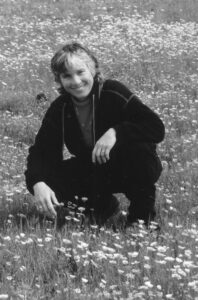
“We’re down to the bottom of what’s left; it’s a cumulative problem,” she said.
A press release from the plaintiffs points out that the site where Valley’s Edge would be located is wildfire prone and in fact burned in 1999, 2007 and 2018. The lawsuit says the EIR underestimates greenhouse gas emissions and impact on groundwater, and fails to “consider the full scope” of projects planned for the area, including the Stonegate subdivision that would be adjacent.
The state’s Fish & Wildlife department responded to the draft EIR with its own critique, also mentioning other development, including Meriam Park. Tanya Sheya commented on the importance of preserving endangered meadowfoam plants and the key role this county will play if there is to be success.
“We have an increased responsibility to take care of what’s left,” said Sheya, environmental program director for habitat conservation. “The more numbers you have, the better the likelihood of survival, and with climate change they have to have resiliency. In the ecosystem as a whole, [the loss of] one little species could change everything.”
Jan. 3 public hearing: Golf carts and cheese shops
Two views of Chico’s future emerged at the Council’s public hearing, named after Bill Brouhard (“Bill’s Chico”) and Councilmember Addison Winslow (“Addison’s Chico.”)
During Brouhard’s Jan. 3 presentation to the Council, he described a planned community with almost 2,800 housing units with one section reserved for senior citizens. Valley’s Edge would include parks, trails and in the senior section, lanes for electric golf carts or bikes. The village core probably wouldn’t attract a major retail outlet, but might, for example, include a specialty cheese shop.
“You’ve designed a beautiful, self-contained town,” said a speaker from the public, Steven Cismowski. “The problem is, the town doesn’t relate to the rest of Chico.”
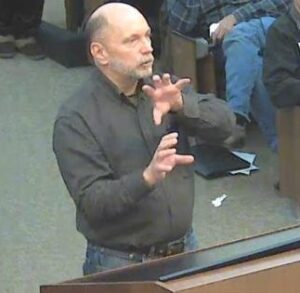
Councilmembers belonging to the conservative majority and city staff indicated they had seen golf carts used as transport in the city of Lincoln, 10 miles north of Roseville. “There’s extensive use of electric vehicles in Lincoln,” said Mayor Andrew Coolidge, referring to the carts. “I dare say there are more of them than cars.”
(Lincoln’s website says it’s “friendly” to golf carts with “dedicated lanes and parking spots.”)
Councilmember Winslow, who cast the sole vote in opposition to the project after offering a compromise motion that died quickly for lack of a second, points out that the carts might be usable to get to a shuttle or neighborhood bus stop — but try getting on a main arterial like the Skyway in a golf cart. He asked for a transportation plan to reduce what he says are under-estimated greenhouse gas emissions.
“We don’t have a city-wide plan for a new mode of transportation,” Winslow said of the golf cart concept. “Because this is proposed as the very end of development forever in Chico … this could be the last opportunity we have to install a major transit stop to reverse the pattern of auto dependency that Chico is in.”
Later Winslow told ChicoSol: “There seems to be some interest in emulating something around Roseville. Golf carts are a cheap way to make it look like we’re providing alternative transportation. But they’re not a replacement for viable public transportation.”
Winslow has also questioned the low-density zonings on the lion’s share of the site, which suggest that home prices could be quite high for most Chico incomes. That led a few Valley’s Edge supporters to speak during the public hearing on behalf of “Bill’s Chico,” saying they didn’t want to live in “Addison’s Chico.”
(Winslow says his vision for compact urban growth doesn’t include high-rise apartments, but instead a “genuine mixture of housing,” including single-family homes, townhouses, and three-story apartment buildings.)
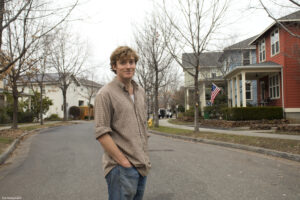
But most speakers opposed the project, often because they were worried about the arguments at the heart of the lawsuit -– fire risks, water use and losing the sheer joy in having open land on Chico’s southeast edge as a “viewshed” and home to wildlife.
Ginger Vogel, a Butte Creek Canyon resident, talked about the destruction caused by the 2018 Camp Fire. “We have in 25 minutes a full town that has been burnt to the ground,” Vogel said as she pled with the Council to oppose Valley’s Edge. “The housing can be go there. Now you’re going to take the little that is left [of nature], you’re taking it all away.”
Allen Harthorn, executive director of Friends of Butte Creek, wrote to the City and spoke at the hearing.
“Butte Creek is where it all drains,” wrote Harthorn. “Every over-watered lawn, washed car … and residential pool overflow will carry pollutants, such as nutrients, fertilizers, pesticides, animal waste from dogs and cats …
“Butte Creek supports the Last Best Run of Threatened Spring Run Chinook Salmon in the State. We simply can’t be chipping away at the fringes of this valuable watershed and dumping the polluted runoff directly into the creek.”
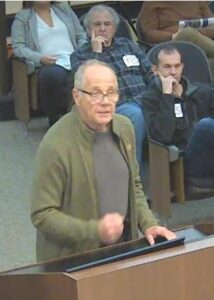
After hearing the Council’s discussion during the public hearing, Harthorn added to his commentary — though perhaps not everyone understood the context for his reference to Lincoln.
“I hope the citizens of Chico don’t envision our foothills like Lincoln, Rocklin and Roseville — or San Jose,” Harthorn said at the podium. “I say ‘No way Lincoln.’”
The seed for clashing visions
Ironically, the tension between growth and conservation in the nearby foothills is rooted in an earlier stop-sprawl success story.
The seeds for the clash were planted in the successful campaign for a “Greenline” that culminated in the summer of 1982. That boundary on the west side of Chico has protected the rich, dark Vinaloam soil from urban sprawl so effectively that liberals — like former Supervisor Jane Dolan — who were instrumental in getting it in place have been able to highlight it as a top professional accomplishment.
But the Greenline came with an unwritten understanding at the time that Chico could expand eastward as needed, sources told ChicoSol. Former City Manager Tom Lando (1992-2006) noted that when the Greenline was adopted, city leadership felt it would be “disadvantageous” to expand to the west.
“Nobody really understood the resources and environmental sensitivity of the land to the east,” Lando said in an interview with ChicoSol. “In the early ‘80s there was no discussion at all about wetlands, meadowfoam or other rare and endangered species.”

Lando said these issues were understood by the time the 2011 General Plan was approved. City leaders believed then that the environmental obstacles could be mitigated; Lando has spoken out in support of that thinking.
In a November letter to the Chico Enterprise-Record, Lando said the Valley’s Edge design shows that “growth can occur while being environmentally sensitive and provide a very large amount of open space and park land.”
Councilmember Tom van Overbeek, a businessman elected last year to represent District 6, recused himself from voting because he owns an adjacent parcel. But he agreed with Lando in a recent letter to the E-R, arguing that Valley’s Edge is the “last opportunity” for eastside growth and protection of the Greenline and “prime farmland” on the west.
Former Mayor Michael McGinnis objects to the connection made between the Greenline and eastside development, and says he never signed off on any such agreement. Said McGinnis: “Developers bring that out when it’s to their advantage, but the Greenline stands on its own. I don’t know that any promises were made. And whether someone promised something 40 years ago is irrelevant.”
McGinnis was on the Council from 1988-1996 and involved in designing a new General Plan in 1994 –- the kind of General Plan that some of the young speakers at the public hearing seemed to yearn for. Liberals lost their majority in 1996 and McGinnis says the plan was never implemented.
“There was the notion that Chico was a special place, surrounded by nature,” McGinnis said. “We wanted more of a compact core that would be economically sound.”
Since then, he said, conservatives have done “a good job of telling people, ‘We need housing,’” and pointing to the problem of homelessness.
“They’ve co-opted all of our principles,” McGinnis said. “They use our language and they talk about how they’re going to save oak trees. They’ve learned all the right language, but they’re not going to provide housing for my son or my grandchildren.”
This is part II in a two-part series on the Valley’s Edge project.
Leslie Layton is editor of ChicoSol. Natalie Hanson contributed reporting to this story.

Wonderful article. So well done and thoroughly researched.
love the picture of Kelly and Mike – wow, Mike, you got to stop eating meat! Hey, anybody remember the time Kelly argued so long with Dan Herbert Dan gave up – he said, “Kelly, you’ve interrupted me so many times I can’t remember what I was going to say…” Mark Sorensen and his consultants have ended the “back and forth” at meetings, the public is being slowly shut out of the process, so now we have to get a lawyer and sue if we don’t like what they’re doing. Good luck with that. Meanwhile we need to get a lawyer to overturn the illegal garbage franchise the city is running. Anybody interested?
Great article – History matters for our future!
Valley’s Edge “would gift a 419-acre regional park to the city, but other open spaces may not be open to the entire community.” So in other words the maintenance and liability of 419 acres of land would be taken out of the tax base at a time when human and pet access impacts on the land expand by several factors, and land access, maintenance and stewardship costs skyrocket at taxpayer expense, as will likely road maintenance for the development as soon as the new roads begin to degrade in 10 or 15 years.
I too would like to be applauded as I “gift” the city my poperty taxes, my gas and electric, sewage, and recreational property insurance fees and bills. By such reasoning, such a generous charitable gift on my part would also qualify me for taking deductions, refunds, and credits on state and federal income taxes. For me and Valley’s Edge developers, that makes our generosities a “we win and win again” proposition.
The point is: This “donation” is: a huge liability, tax and stewardship burden for the Chico Community; and a tax and responsibility write-off, and Trojan Horse for Valley’s Edge developers.
Thank you, ChicoSol for this comprehensive article and the walk down memory lane, complete with the amazing photo of McGinnis, Evans and our beloved, cranky Kelly Meagher, may he rest in peace – or be fighting with us from the heavens! No way, San Jose! No way Lincoln! No way, Valley’s Edge!
An excellent article! The background is so important as well.
In the 1994 General Plan Task Force I represented the Chico coalition for Aesthetic Development (CCAD), a group of professional artists, architects and landscape architects). Our vision for Chico (the “Ring Transportation Corridor “ RTC) was written into the General Plan. Fast Forward 30 years… the vision – a transit loop around the inner city with mixed use housing, wide sidewalks, tree canopies and small electric buses – has never been realized.
Yes, we had a financial upset in 2008, a potential city bankruptcy, the 2010 General Plan (which fragmented the RTC vision); the 2018 Camp Fire, which gave us an additional 20,000 people from Paradise overnight, 10,000 of whom remained, necessitating another well-overdue General Plan, and a 2020 global pandemic. Meanwhile, young people and our workforce have seen the cost of housing and rents skyrocket to the point of not being affordable, not to mention our homeless population.
Our Smart Growth Advocates (SGA) group are not “no growthers”, as some others assert. We want to provide an alternative which doesn’t exist in Chico – yet. We don’t have to reinvent the wheel. It’s been done all over the US.
Mixed use housing on underutilized transit corridors like Park Avenue, Downtown, Mangrove, and the K Mart area, with walkable sidewalks and attractive stores on the first of 2,3,4 story buildings, would provide a much -needed housing alternative. A three bedroom two bath house is not what everyone wants, or can afford at median level $425,000 and higher.
We at SGA see Valley’s Edge as urban sprawl, and a misuse of our precious open space. And we also see it as the “tip of the iceberg”, encouraging big development down the southeast side of Chico. I agree with what Michael McGinnis said: protecting the Green Line in the ‘80’s did not mean ‘yes’ to big development on the east side, particularly in the foothills, our only viewshed.
We need to realize our extreme weather events are exacerbating climate change, and that developments like Valley’s Edge would create unmitigatable carbon emissions, increasing climate change. There need to be housing choices like Smart Growth, which meet the needs of many people in Chico, reduce our carbon emissions, and can provide affordable (attractive) housing for young people and older people who want to downsize. Smart Growth can be the solution, can revitalize our Downtown and underutilized nearby areas, create a healthy walkable lifestyle, safety, and a sense of community.